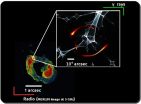Examining the neonicotinoid threat to honey bees
2015-07-08
(Press-News.org) The decline of honey bees has been a major concern globally for the past decade. One of the factors that could be contributing to the decline is the use of insecticides -- specifically neonicotinoids -- that persist in rivers and streams. Researchers now report in the ACS journal Environmental Science & Technology Letters that although sunlight plays an important role in degrading pollutants, its effects on neonicotinoids can diminish dramatically even in shallow water.
Neonicotinoids protect crops from pests, such as whiteflies, beetles and termites. They are a popular tool in a farmer's arsenal, but they end up washing into surface waters and soil. Some research has suggested the insecticides play a role in the disappearance of bees, a phenomenon known as colony collapse disorder. But scientists didn't fully understand the fate of neonicotinoids in the environment, an important factor in determining how they might contribute to the disorder. Charles S. Wong and colleagues wanted to investigate sunlight's effects on these insecticides in water.
Out of five neonicotinoids the researchers tested in water under simulated sunny conditions, three degraded considerably within minutes.
Two took a few days to break down. But a depth of just 3 inches of water was enough to shield at least one, thiamethoxam, from the degrading effects of the sun. The researchers say that this persistence at shallow depths could increase the chances aquatic life and other wildlife, including bees, could get exposed to the insecticide.
INFORMATION:
The authors acknowledge funding from the Natural Sciences and Engineering Research Council of Canada, the University of Manitoba and the Canada Research Chairs Program.
The American Chemical Society is a nonprofit organization chartered by the U.S. Congress. With more than 158,000 members, ACS is the world's largest scientific society and a global leader in providing access to chemistry-related research through its multiple databases, peer-reviewed journals and scientific conferences. Its main offices are in Washington, D.C., and Columbus, Ohio.
To automatically receive news releases from the American Chemical Society, contact newsroom@acs.org.
Follow us: Twitter Facebook
ELSE PRESS RELEASES FROM THIS DATE:
2015-07-08
Today Nicotine & Tobacco Research publishes the third in a series of studies on the cost of smoking in California, one of the first US states to implement a comprehensive tobacco control program. Researchers estimated expenditures for smoking-attributable costs (healthcare, lost productivity from illness, and lost productivity from premature mortality) for the year 2009. The total cost came to $18.1 billion, amounting to $487 per California resident and $4,603 per smoker.
In two previous studies, conducted in 1989 and 1999, the annual financial impact of smoking on California's ...
2015-07-08
Some of the world's most popular foods and seasonings can also be the smelliest -- think garlic, onions, certain cheeses and the notoriously stinky Asian durian fruit. No amount of plastic wrap seems to contain their stench, but now scientists have developed a new film that could finally neutralize the odors of even the most pungent fare. They report their progress in the journal ACS Applied Materials & Interfaces.
The fetid smell of some foods makes it difficult to take them anywhere without offending others such as fellow train or bus riders. But tastes are growing ...
2015-07-08
A microbiome code breaker. A carbon dioxide (CO2) wrangler. A bug battler. These aren't members of a new group of super heroes, but a sampling of "The Talented 12" young scientists and entrepreneurs that Chemical & Engineering News (C&EN) magazine is highlighting in a special feature in the latest edition. C&EN is the weekly news magazine of the American Chemical Society (ACS), the world's largest scientific society.
"The Talented 12" includes profiles of a dozen of the best and brightest young researchers who are using chemistry to solve global problems. Among other ...
2015-07-08
This news release is available in German.
Turbulent processes take place close to supermassive black holes, which lurk in the centres of nearly all galaxies. They swallow up matter flowing in from the outside while at the same time producing so-called gas jets which shoot out into space in two opposite directions. Researchers at the Max Planck Institute for Physics in Munich and the University of Geneva have now succeeded in localizing the origin of the high-energy gamma radiation in such a jet: it apparently originates very close to the black hole. This discovery ...
2015-07-08
New findings about the mechanisms involved - or not involved - in the effects of the most common form of bariatric surgery suggest that combining surgery with a specific type of medication could augment the benefits of the procedure. In a report that has been published online in the journal Endocrinology, Massachusetts General Hospital (MGH) investigators report that the effects of Roux-en-Y gastric bypass (RYGB) do not utilize neurologic pathways controlled by the serotonin 2C receptor. Since that receptor is a proven target for the FDA-approved anti-obesity drug lorcaserin, ...
2015-07-08
SPOKANE, Wash.--Washington State University researchers have found that people can manage chronic pain and reduce their reliance on opioids through an Internet-based program that teaches non-medical alternatives like increased physical activity, thinking more positively and dealing with emotions.
Marian Wilson, an assistant professor in the College of Nursing, tracked 43 people with chronic non-cancer pain as they went through an eight-week course of online tools to manage psychological, social and health issues associated with chronic pain. Compared to a similar-sized ...
2015-07-08
Researchers have developed a way to help ecosystems bounce back after human disturbances such as shipping, oil exploration or fishing, and have applied it to a coral reef fish species.
The method helps conservation managers create a cost-effective plan to bring species back from the brink of extinction in a local area, by building connections with the same species in nearby locations.
"The world is subject to nasty surprises, and this work for the first time shows how to promote faster species recovery following such a surprise," said Professor Quentin Grafton from ...
2015-07-08
In the life of almost every household appliance, there comes that moment of out with the old and in with the new.
However, while electrical and electronic equipment have never been more efficient, economical or in demand, consumers' desire to own the best and the latest is contributing to an environmental issue of increasing seriousness and concern.
"E-waste is one of the fastest growing waste streams in developing, emerging and developed regions and it covers all electrical and electronic equipment and parts discarded by consumers," says Dr Sunil Herat, Associate Editor ...
2015-07-08
Nanowires are wired-shaped materials with diameters that are tens of nanometers or less. There are many types of nanowires, including semiconducting composite nanowires, metal oxide composite nanowires, and organic polymer nanowires, and they are typically used in functional materials and devices used as sensors, transistors, semiconductors, photonics devices, and solar cells.
Molecular wires composed of only inorganic materials have attracted significant attention due to their stable structures, tunable chemical compositions, and tunable properties. However, there have ...
2015-07-08
The research team led by Dr. Jongsoo Jurng and Dr. Gwi-Nam at KIST stated that, "In cooperation with KT&G, KIST has developed a nano-catalyst filter coated with a manganese oxide-based nano-catalyst, which can be used in a smoking room to reduce and purify major harmful substances of cigarette smoke. the KIST-developed catalyst removes 100% of the particle substances of cigarette smoke, such as nicotine and tar, converting those into water vapor and carbon dioxide. According to the research team, the air cleaning equipment based on the newly-developed catalyst can purify ...
LAST 30 PRESS RELEASES:
[Press-News.org] Examining the neonicotinoid threat to honey bees




